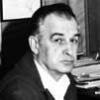
Woodrow "Woody" Johansen was interviewed on January 4, 1985 by Gayle Maloy in Fairbanks, Alaska. In this interview, Woody talks about working on construction of the Winter Haul Road (Hickel Highway), building an ice bridge across the Yukon River, hiring Alaska Natives from Stevens Village, the toughness of the road construction crew, and dealing with cold temperatures and challenging conditions.
Digital Asset Information
Project: Dalton Highway
Date of Interview: Jan 4, 1985
Narrator(s): Woodrow "Woody" Johansen
Interviewer(s): Gayle Maloy
After clicking play, click on a section to navigate the audio or video clip.
Sections
1) Introduction and history of road building agencies in Alaska
2) Early road and bridge projects in Fairbanks
3) Problems in the early days of administering contract work for the Alaska Road Commission
4) Winter ice road from Livengood to Prudhoe Bay
5) Getting crews and equipment organized for early stages of building the winter ice road
6) Building an ice bridge
7) Reaching the Yukon River, continuing to build the winter ice road to Sagwon, and modifying equipment for winter use
8) Dealing with cold winter temperatures while building the winter ice road
Click play, then use Sections or Transcript to navigate the interview.
After clicking play, click a section of the transcript to navigate the audio or video clip.
Transcript
Section 1: Alaska Road Commission\ road -- building\ federal agency\ Bureau of Public Roads\ Alaska Road Commission -- end of\ work -- state highway department\ Alaska statehood\ contract -- Bureau of Public Roads\ Alaska Department of Highways\ work -- same\ people -- same\ employment -- transfer\ Department of Transportation and Public Facilities|
Section 2: Alaska Road Commission\ employment\ crews -- internal\ contract work\ bridge\ Noyes Slough\ Fairbanks\ Minnie Street\ access\ bridge -- walking\ bridge -- swinging\ bridge -- suspension\ road -- paving\ College Road|
Section 3: Alaska Road Commission\ contract -- administration\ problems -- dealing with\ contractor -- payment to\ paperwork\ procedures -- development of\ estimate -- approval of\ payment -- approval of\ problems -- lack of
Section 4: "The Winter Haul Road was close to my heart. An exciting project", says Woodrow Johansen. In 1968, oil was discovered at Prudhoe Bay, Alaska. A number of contractors were needed to deliver supplies and trailer houses up north so laborers could work in the oil fields. Alaska Governor Walter Hickel suggested that a winter ice road be built (an idea mentioned in October 1968). Woodrow Johansen was a District Engineer for the Alaska State Highway Department. He was informed that the Highway Department was going to build a winter ice road (winter haul road) from Livengood to the Yukon River in November 1968.
Section 5: The Department had no equipment for that type of operation. The crew had to assemble "Go Devils" and put living quarters in trailers; build a mobile generating plant; assemble "Go Devils" to carry oil, fuel; and build a mess hall, bunk house, and cook house. The crew started to construct the winter ice road from Livengood to the Yukon River, while Woody sent a crew to the Yukon River to build an ice bridge. The ice bridge crew traveled to Stevens Village and hired Alaska Natives to build the ice bridge. Woody had hoped by the time his crew built the winter ice-road to the Yukon River and the ice bridge, the contract would be prepared for a contractor to take over.
Section 6: An ice bridge is a strengthening of the ice so it will carry a heavy load. To build an ice bridge, two snow berms are built and laid parallel across the ice. The two berms are laid 50 feet apart, creating the width of the road. Then, the crew would dig holes through the Yukon River ice, and pump water to thicken the ice between the berms. In addition, the crew laid three rows of spruce trees across the river and berms for strength.
Section 7: The crew building the winter ice road reached the Yukon River a week before Christmas. Woody had thought his part of the job was complete. The crew waited at the south-bank of the Yukon River for directions from Woody. About the first of the year, Woody received orders from the Governor of Alaska that his crew would build the winter ice road to Sagwon. The crew had to rent and modify equipment to continue the construction of the winter ice road north.
Section 8: The temperature at the Yukon River was extremely cold. It was 60 - 70 degrees below zero. The crew was immobilized. When the crew picked up an electrical wire to move it, the insulation would fall off. The kerosene froze. The diesel oil was so thick it wouldn't run the engines. Conditions were miserable. Everyday Woody would receive a call from the Alaska Road Commissioner in Juneau, asking why the crew stopped working. Finally, Woody received a call saying if the crew does not move soon, the project would be terminated. Just about that time, the weather warmed up, and the crew headed north. The commissioner called Woody again saying the governor (Walter Hickel) wanted him to shut the construction project down. According to Woody, "Well, I had no radio communication with my crew (at that time), so we couldn't (inform them to) shut it down. The crew kept going. The crew went to Bettles, up the John River, through Anaktuvuk Pass, and into Sagwon. Woody closes by saying, "What an experience. Without the crew that we had, we would never had made it".

